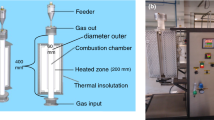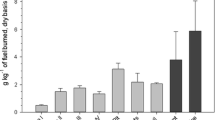Pinus radiata
D. Don) at 100 °C dry bulb and 70 °C wet bulb, were assessed by measuring the concentration of chemical components in the kiln atmosphere at regular time intervals and determining air-flows and temperature differentials across the stack. The volatile organic compounds (VOC) were trapped on activated carbon and analyzed by GC-MS. The aldehydes were trapped in 2,4-dinitrophenol-hydrazine solution and the aldehyde derivatives analysed by HPLC. Polar compounds were trapped in water and then alcohols were analysed by GC and organic acids by ion exchange chromatography. The two major VOC found were α-pinene and β-pinene, which made up 90% of the total discharge (405 g/m3 wood). Most of the VOC fraction was released during the early stages of drying. The release of potentially hazardous components (formaldehyde, acetaldehyde, furfural) was found to be relatively low (1.1, 8.7, and 0.1 g/m3 wood, respectively) provided the kiln emissions are well dispersed, these levels of release are unlikely to cause adverse environmental effects.
P. radiata
D. Don) wurden abgeschätzt. Die Trockentemperatur betrug 100 °C, die Feuchttemperatur 70 °C. Chemische Komponenten in der Ofenluft wurden in regelmäßigen Zeitintervallen gemessen sowie die Luftbewegungen und Temperaturdifferenzen innerhalb des Holzstapels bestimmt. Die flüchtigen organischen Bestandteile (VOC) wurden an Aktivkohle adsorbiert und mittels GC-MS analysiert. Aldehyde wurden in Lösungen von 2,4-Dinitrohydrazin aufgefangen und die entsprechenden Aldehydderivate mittels HPLC analysiert. Polare Komponenten wurden in Wasser absorbiert, wonach die Alkohole mittels GC und die organischen Säuren mit Ionenaustauschern aufgetrennt wurden. Die Hauptkomponenten der VOC waren Alpha- und Beta-Pinen, die zusammen 90% des Massenverlustes (405 g/m3 Holz) ausmachten. Die Hauptmenge wurde im frühen Trockungsstadium freigesetzt. Die Freisetzung von eventuell schädlichen Komponenten war relativ gering (Formaldehyd 1,1 g/m3, Acetaldehyd 8,7 g/m3 und Furfural 0,1 g/m3). Wenn die Ofenabluft gut verdünnt ist, sollten diese Mengen kaum Umweltschäden verursachen.
Similar content being viewed by others
Author information
Authors and Affiliations
Rights and permissions
About this article
Cite this article
McDonald, A., Dare, P., Gifford, J. et al. Assessment of air emissions from industrial kiln drying of Pinus radiata wood. Holz als Roh- und Werkstoff 60, 181–190 (2002). https://doi.org/10.1007/s00107-002-0293-1
Issue Date:
DOI: https://doi.org/10.1007/s00107-002-0293-1




